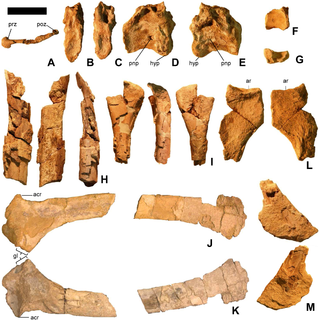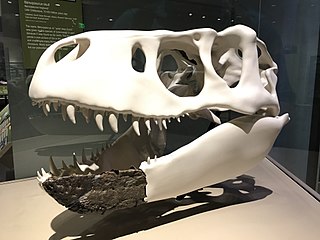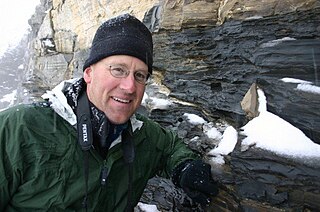Related Research Articles

A bone bed is any geological stratum or deposit that contains bones of whatever kind. Inevitably, such deposits are sedimentary in nature. Not a formal term, it tends to be used more to describe especially dense collections such as Lagerstätte. It is also applied to brecciated and stalagmitic deposits on the floor of caves, which frequently contain osseous remains.

Pachyrhinosaurus is an extinct genus of centrosaurine ceratopsid dinosaur from the Late Cretaceous period of North America. The first examples were discovered by Charles M. Sternberg in Alberta, Canada, in 1946, and named in 1950. Over a dozen partial skulls and a large assortment of other fossils from various species have been found in Alberta and Alaska. A great number were not available for study until the 1980s, resulting in a relatively recent increase of interest in Pachyrhinosaurus.

Garudimimus is a genus of ornithomimosaur that lived in Asia during the Late Cretaceous. The genus is known from a single specimen found in 1981 by a Soviet-Mongolian paleontological expedition in the Bayan Shireh Formation and formally described in the same year by Rinchen Barsbold; the only species is Garudimimus brevipes. Several interpretations about the anatomical traits of Garudimimus were made in posterior examinations of the specimen, but most of them were criticized during its comprehensive redescription in 2005. Extensive undescribed ornithomimosaur remains at the type locality of Garudimimus may represent additional specimens of the genus.

Adasaurus is a genus of dromaeosaurid dinosaur that lived in Asia during the Late Cretaceous period about 70 million years ago. The genus is known from two partial specimens found in the Nemegt Formation of Mongolia that were partially described in 1983 by the paleontologist Rinchen Barsbold.

Lanzhousaurus is a genus of ornithopod dinosaur. Lanzhousaurus lived in the Gansu region of what is now China during the Early Cretaceous (Barremian). A partial skeleton has been recovered from the Hekou Group. It was described by You, Ji and Li in 2005 and the type and only species is Lanzhousaurus magnidens. It's been estimated to be about 10 meters in length and 6 tonnes in weight.

Hațeg Island was a large offshore island in the Tethys Sea which existed during the Late Cretaceous period, probably from the Cenomanian to the Maastrichtian ages. It was situated in an area corresponding to the region around modern-day Hațeg, Hunedoara County, Romania. Maastrichtian fossils of small-sized dinosaurs have been found in the island's rocks. It was formed mainly by tectonic uplift during the early Alpine orogeny, caused by the collision of the African and Eurasian plates towards the end of the Cretaceous. There is no real present-day analog, but overall, the island of Hainan is perhaps closest as regards climate, geology and topography, though still not a particularly good match. The vegetation, for example, was of course entirely distinct from today, as was the fauna.

The Prince Creek Formation is a geological formation in Alaska with strata dating to the Early Maastrichtian stage of the Late Cretaceous. Dinosaur remains are among the fossils that have been recovered from the formation.
The Villar del Arzobispo Formation is a Late Jurassic to possibly Early Cretaceous geologic formation in eastern Spain. It is equivalent in age to the Lourinhã Formation of Portugal. It was originally thought to date from the Late Tithonian-Middle Berriasian, but more recent work suggests a Kimmeridigan-Late Tithonian, possibly dating to the Early Berriasian in some areas. The Villar del Arzobispo Formation's age in the area of Riodeva in Spain has been dated based on stratigraphic correlations as middle-upper Tithonian, approximately 145-141 million years old. In the area of Galve, the formation potentially dates into the earliest Cretaceous.
The Seonso Conglomerate is a Cretaceous aged geologic formation in South Korea. Fossil of Asprosaurus, Koreanosaurus and dinosaur eggs have been reported from the formation.
Anthony Ricardo Fiorillo is a senior fellow at the Institute for the Study of Earth and Man at Southern Methodist University, but for many years he was vice president of research & collections and chief curator at the Perot Museum of Nature & Science. A native of Connecticut, he received his bachelor's at the University of Connecticut, his master's at the University of Nebraska and a Ph.D. in Vertebrate Paleontology from the University of Pennsylvania.

Geminiraptor is a genus of troodontid theropod dinosaur that lived in North America during the Early Cretaceous period. Geminiraptor was a small, ground-dwelling bipedal carnivorous paravian. The type species of Geminiraptor is G. suarezarum.

Martharaptor is a genus of therizinosauroid theropod dinosaurs from the Early Cretaceous of the Cedar Mountain Formation in Utah. They can be distinguished from other therizinosauroids by means of several features of the skeleton which were intermediate between early therizinosaurs such as Falcarius and Beipiaosaurus, and more "advanced" members of the group like therizinosaurids. The deep and homogeneous hand claws clearly differ from the case in early therizinosauroids, but the foot has not yet acquired the robust morphology of therizinosaurids.

Paleontology in Alaska refers to paleontological research occurring within or conducted by people from the U.S. state of Alaska. During the Late Precambrian, Alaska was covered by a shallow sea that was home to stromatolite-forming bacteria. Alaska remained submerged into the Paleozoic era and the sea came to be home to creatures including ammonites, brachiopods, and reef-forming corals. An island chain formed in the eastern part of the state. Alaska remained covered in seawater during the Triassic and Jurassic. Local wildlife included ammonites, belemnites, bony fish and ichthyosaurs. Alaska was a more terrestrial environment during the Cretaceous, with a rich flora and dinosaur fauna.

Nanuqsaurus is a genus of carnivorous tyrannosaurid theropod known from the Late Cretaceous period Prince Creek Formation of the North Slope of Alaska, United States. It contains a single species, Nanuqsaurus hoglundi, known only from a partial skull and multiple undescribed postcranial and teeth elements.
Francisca Oboh-Ikuenobe is a geologist from Ubiaja in Esan South East Local Government Area of Edo State. She specialises in palynology and sedimentology, and is Professor of Geology in the Department of Geosciences and Geological and Petroleum and Engineering, and Associate Dean of Academic Affairs in the College of Engineering and Computing, Missouri University of Science and Technology.

John Russell Foster is an American paleontologist. Foster has worked with dinosaur remains from the Late Jurassic of the Colorado Plateau and Rocky Mountains, as well as working on Cambrian age trilobite faunas in the southwest region of the American west. He named the crocodiliform trace fossil Hatcherichnus sanjuanensis in 1997 and identified the first known occurrence of the theropod trace fossil Hispanosauropus in North America in 2015.

Mierasaurus is an extinct genus of sauropod dinosaur from the Early Cretaceous of Utah, United States. The taxon was first described and named in 2017 by Rafael Royo-Torres and colleagues, from a mostly complete skeleton including a disarticulated partial skull and mandible, teeth, multiple vertebrae from along the length of the body, both scapulae, radius and ulna bones, a left manus, a complete pelvis, both femora and the entire left hindlimb. Additionally, they referred a lower jaw and femur from juvenile individuals, which were found nearby, to the genus. Collectively, Mierasaurus is among the most completely known North American sauropods. The genus name honours Bernardo de Miera y Pacheco, the first European scientist to enter what is now Utah. The type species for Mierasaurus is Mierasaurus bobyoungi, named after Robert Glen Young, a paleontologist who researched the Early Cretaceous of Utah.

Adynomosaurus is a genus of lambeosaurine dinosaur from the Late Cretaceous of what is now Catalonia, Spain. First discovered in 2012, it was named in 2019 with the type and only species Adynomosaurus arcanus, as an addition to the very incomplete fossil record of hadrosaurides dinosaurs from the Late Cretaceous of Europe. It is only known from scant material, but is distinguished from other hadrosaurs by its weakly developed shoulder blade which would have had underdeveloped musculature, which lends it its scientific name, partially from the Greek word for "weak". Its exact relationships with other hadrosaurs remain unresolved, with it not consistently being recovered as a relative of any other specific genera, though some studies have allied it with Tsintaosaurini or even found it outside of Hadrosauridae. It would have lived as part of a diverse coastal estuaryweak ecosystem, made up of meandering rivers and mud flats, and fits into a picture of major ecological turnover in the Maastrichtian age of Europe.
The Nevadaplano was a high plateau that is proposed to have covered parts of southwestern North America during the late Mesozoic and early Cenozoic, located in the present-day US states of Idaho, Nevada, Utah and possibly others. It most likely formed during the Cretaceous as a consequence of subduction dynamics and may have reached elevations of 3 kilometres (9,800 ft) and more, although its elevation is controversial. It was flanked on the west by the Sierra Nevada, which was traversed by various valleys that came down from the Nevadaplano. Closed basins and numerous volcanic calderas covered the relatively flat Nevadaplano; large volcanic eruptions distributed ignimbrites over the plateau and down the valleys draining it.
This article records new taxa of fossil archosaurs of every kind that are scheduled described during the year 2022, as well as other significant discoveries and events related to paleontology of archosaurs that are scheduled to occur in the year 2022.
References
- ↑ "Celina A. Suarez | Directory | University of Arkansas". fulbright.uark.edu. Retrieved 2020-07-14.
- 1 2 "A Q&A with Geosciences' Celina Suarez". February 1, 2019. Retrieved July 14, 2020.
- 1 2 "Emerging Scholar Profile: Suarez Makes Geological History". Diverse. 2018-02-06. Retrieved 2020-07-15.
- ↑ "Celina Suarez | Deep-Time Paleoclimate Research Group". wordpressua.uark.edu. Retrieved 2020-07-15.
- ↑ "DinoFest 2017 Speaker: Dr. Celina A. Suarez". Natural History Museum of Utah. 2016-12-14. Retrieved 2020-07-15.
- ↑ "Celina Suarez « News from The Johns Hopkins University" . Retrieved 2020-07-15.
- ↑ Moeller, Katy (2011-02-13). "Dinosaur species named for BSU student, sister". The Times-News. The Idaho Statesman. p. 8. Retrieved 2020-10-02– via Newspapers.com.
- ↑ "Trace Element and Radiogenic Isotope Lab |". icp.uark.edu. Retrieved 2020-07-15.
- ↑ "Arkansas geosciences researcher awarded inaugural Deep Carbon Observatory Diversity grant | News". EPSCoR/IDeA Foundation. 2016-05-31. Retrieved 2020-07-15.
- ↑ "Fulbright College Announces 2019 Winners of King, Nolan and OMNI Awards". University of Arkansas News. Retrieved 2020-07-15.
- ↑ Suarez, Celina A.; Morschhauser, Eric M.; Suarez, Marina B.; You, Hailu; Li, Daqing; Dodson, Peter (2018-12-13). "Rare earth element geochemistry of bone beds from the Lower Cretaceous Zhonggou Formation of Gansu Province, China". Journal of Vertebrate Paleontology. 38 (sup1): 22–35. doi:10.1080/02724634.2017.1400441. ISSN 0272-4634. S2CID 202867203.
- ↑ Suarez, Celina A.; Knobbe, Todd K.; Crowley, James L.; Kirkland, James I.; Milner, Andrew R. C. (2017-10-01). "A chronostratigraphic assessment of the Moenave Formation, USA using C-isotope chemostratigraphy and detrital zircon geochronology: Implications for the terrestrial end Triassic extinction". Earth and Planetary Science Letters. 475: 83–93. Bibcode:2017E&PSL.475...83S. doi:10.1016/j.epsl.2017.07.028. ISSN 0012-821X.
- ↑ Suarez, Celina A.; You, Hai-Lu; Suarez, Marina B.; Li, Da-Qing; Trieschmann, J. B. (2017-11-10). "Stable Isotopes Reveal Rapid Enamel Elongation (Amelogenesis) Rates for the Early Cretaceous Iguanodontian Dinosaur Lanzhousaurus magnidens". Scientific Reports. 7 (1): 15319. Bibcode:2017NatSR...715319S. doi: 10.1038/s41598-017-15653-6 . ISSN 2045-2322. PMC 5681512 . PMID 29127359. S2CID 1637631.
- ↑ Suarez, Celina A.; Flaig, Peter P.; Ludvigson, Gregory A.; González, Luis A.; Tian, Ryan; Zhou, Huajun; McCarthy, Paul J.; Van der Kolk, Dolores A.; Fiorillo, Anthony R. (2016-01-01). "Reconstructing the paleohydrology of a cretaceous Alaskan paleopolar coastal plain from stable isotopes of bivalves". Palaeogeography, Palaeoclimatology, Palaeoecology. Selected papers based on Geological Society of America, Annual Meeting, Theme Session 241, Ancient Polar Ecosystems and Climate History in Deep Time, Denver, Colorado, USA, 30 October 2013. 441: 339–351. Bibcode:2016PPP...441..339S. doi:10.1016/j.palaeo.2015.07.025. ISSN 0031-0182.
- ↑ Suarez, Celina A.; González, Luis A.; Ludvigson, Gregory A.; Kirkland, James I.; Cifelli, Richard L.; Kohn, Matthew J. (2014-11-01). "Multi-Taxa Isotopic Investigation of Paleohydrology In the Lower Cretaceous Cedar Mountain Formation, Eastern Utah, U.S.A.: Deciphering Effects Of the Nevadaplano Plateau On Regional ClimateINFLUENCE OF THE NEVADAPLANO PLATEAU ON A CRETACEOUS FORELAND BASIN". Journal of Sedimentary Research. 84 (11): 975–987. doi:10.2110/jsr.2014.76. hdl: 1808/19198 . ISSN 1527-1404.
- ↑ Suarez, Celina A.; Ludvigson, G. A.; Gonzalez, L. A.; Fiorillo, A. R.; Flaig, P. P.; McCarthy, P. J. (January 2013). "Use of multiple oxygen isotope proxies for elucidating Arctic Cretaceous palaeo-hydrology | Isotopic Studies in Cretaceous Research | GeoScienceWorld Books | GeoScienceWorld". doi:10.1144/SP382.3. S2CID 130744601.
{{cite journal}}: Cite journal requires|journal=(help) - ↑ "Water utilization of the Cretaceous Mussentuchit local fauna, Cedar Mountain Formation, UT, USA: documentation of terrestrial water reservoirs: Palaeogeography, Palaeoclimatology, Palaeoecology" (PDF).
- ↑ Suarez, Celina A.; Macpherson, G. L.; González, Luis A.; Grandstaff, David E. (2010). "Heterogeneous rare earth element (REE) patterns and concentrations in a fossil bone: Implications for the use of REE in vertebrate taphonomy and fossilization history". Geochimica et Cosmochimica Acta. 74 (10): 2970–2988. Bibcode:2010GeCoA..74.2970S. doi:10.1016/j.gca.2010.02.023. ISSN 0016-7037.
- ↑ Suarez, Celina A.; Suarez, Marina B.; Terry, Dennis O.; Grandstaff, David E. (2007). "Rare Earth Element Geochemistry and Taphonomy of the Early Cretaceous Crystal Geyser Dinosaur Quarry, East-Central Utah". PALAIOS. 22 (5): 500–512. Bibcode:2007Palai..22..500S. doi:10.2110/palo.2005.p05-126r. ISSN 0883-1351. S2CID 129048142.